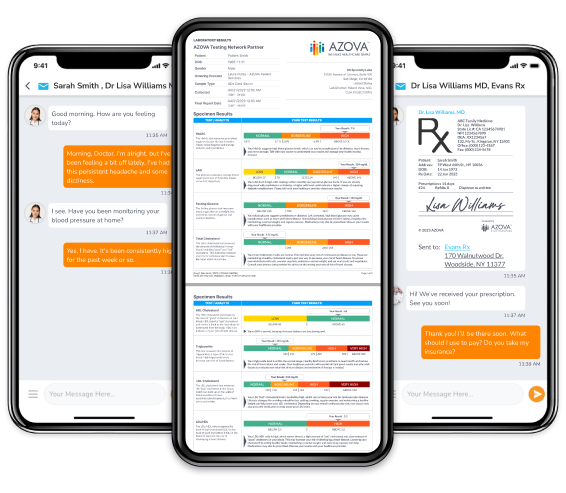Reliable fever treatment, just a click away.
Connect with a board-certified healthcare provider for fever relief via a quick, secured video visit or messaging. Receive a diagnosis and treatment plan, all without leaving home.
Available in all 50 states.

Understanding fevers
A fever occurs when your body’s temperature rises above the normal range of 98-100°F (36-37°C). It’s a common symptom of infections, as your body’s immune system works to fight off the invading pathogens. While fevers can often resolve on their own, a severe fever may indicate a more serious condition that requires medical attention.
When considered a fever¹
- Adults and children: A temperature of 100.4°F (38°C) or higher (taken orally) is generally considered a fever.
- Babies (under 1 year): A temperature of 99°F (37.2°C) or higher taken under the armpit or 100.4°F (38°C) or higher taken rectally is a sign of fever.
- Fever symptoms in adults
- Fever symptoms in children
- Fever causes in adults
- Fever causes in children
- Fever treatments for adults
- Fever treatments for children
Fever symptoms in adults²
A fever that doesn’t go away, even if it’s mild, can be a sign of something more serious. This is because it might indicate a deeper infection or health problem. Common fever symptoms include:
- Chills (shivering)
- Fatigue
- Headaches
- Loss of appetite
- Muscle pain
- Sweating
- Weakness
Fever symptoms in children³
In most healthy children who are behaving normally, a fever is not a cause for major concern. However, there are a few situations where a fever might indicate a more serious illness. Common symptoms of fever in kids include:
- Feeling warm
- Acting differently (fussy, cranky, or quieter than usual)
- Increased breathing or heart rate
- Headache
- Chills or sweating
- Red or flushed skin
The fever is likely not serious if your child is 3 months or older and exhibits the following signs:
- Remains interested in playing
- Drinks fluids adequately
- Appears alert and smiling
- Maintains normal skin color
- Looks well after the fever subsides
While it’s common for children with fevers to eat less, a decreased appetite is usually not a significant issue as long as they are drinking fluids and urinating normally.
Fever causes in adults¹
A fever is a common symptom that occurs when your body’s temperature rises above normal. While it’s often a sign of an infection, the specific causes of fever can vary widely.
If you have serious fever symptoms, let your doctor know if you’ve recently traveled to a different country or attended a crowded event. This may help identify the cause of your fever. Common causes include:
- Viral infections (e.g., flu, cold)
- Bacterial infections
- Fungal infections
- Food poisoning
- Heat exhaustion
- Severe sunburn
- Inflammation (e.g., from rheumatoid arthritis)
- Tumors
- Blood clots
Adults with certain underlying health conditions or who’ve undergone specific treatments may be at a higher risk of developing a serious fever. If such is your case, it’s important to inform your doctor about any fever symptoms you experience.
Fever causes in children
Fevers in children are often a sign of an infection, which can stimulate the immune system to combat the illness.
The high body temperature makes it more difficult for the bacteria and viruses that cause infections to survive. Common conditions that can cause fevers include:
- Upper respiratory tract infections (RTIs)
- Flu
- Ear infections
- Roseola
- Tonsillitis
- Kidney or urinary tract infections (UTIs)
- Teething
- Common childhood illnesses, such as chickenpox and whooping cough
Your child’s temperature can also be raised after vaccinations, or if they overheat because of too much bedding or clothing.
Fever treatments for adults²
Fevers are often a normal response to illness. While they can be uncomfortable, they usually aren’t dangerous. Here’s how to find relief at home:
- Stay hydrated: Drink plenty of fluids to prevent dehydration
- Eat light: Opt for easy-to-digest foods
- Rest up: Get ample sleep to aid recovery
- Over-the-counter relief: Consider using ibuprofen, naproxen, or acetaminophen to reduce pain and fever
- Cool down: Take a lukewarm bath or apply damp cloths to your forehead and wrists
When to seek medical attention²
In-person care
If your fever is accompanied by severe headaches, dizziness, sensitivity to light, neck stiffness, a skin rash, difficulty breathing, frequent vomiting, dehydration, stomach pain, muscle cramps, confusion, or seizures, it could be a sign of a serious illness. Additional warning signs include pain when urinating, decreased urination, dark urine, and urine with a foul odor. These symptoms typically warrant an in-person visit to the emergency room or urgent care center for immediate evaluation.
AZOVA Virtual Urgent Care
For milder symptoms like a low-grade fever, minor respiratory issues, or other non-life-threatening concerns, a Virtual Urgent Care visit can provide quick access to a healthcare provider from the comfort of your home.
Fever treatments for children³
When your child has a fever, it’s important to monitor them closely. Encourage rest, and offer plenty of liquids to help replace fluids lost through sweating. Here’s what you can do at home:
Medications
For discomfort or low fluid intake, give acetaminophen (Tylenol) or ibuprofen (Advil). Avoid ibuprofen for children under 6 months and follow dosage instructions. Consult your doctor for children under 2 or with other health conditions. Never give aspirin and avoid fever medicine for infants under 3 months, unless advised by a doctor.
Comfort
Dress your child in lightweight clothes with a light sheet. Keep the room comfortable, and encourage rest without strict bed rest. Keep them home from school until fever-free for 24 hours. Avoid sponge baths, alcohol rubs, and ice packs.
Hydration and nutrition
Offer plenty of fluids like water or soup. Avoid caffeine. Let your child eat what they want, but don’t force them if they’re not hungry.
When to seek medical attention³
In-person care
If your newborn is less than 3 months old and has a rectal temperature of 100.4°F (38°C) or higher, it’s crucial to seek medical help right away. This situation typically requires in-person care. For children with underlying health conditions, it’s important to consult your doctor to establish guidelines for when to contact them about a fever.
AZOVA Virtual Urgent Care
Virtual Urgent Care can be a convenient option for discussing symptoms and getting advice, but follow your doctor’s specific recommendations on when in-person care is necessary.
Don’t suffer through a fever. Get treatment today.
References
¹Healthline. (n.d.). Symptoms of Fever in Adults, Children, and Babies, and When to Seek Help. Retrieved from https://www.healthline.com/health/fever-symptoms
²Harvard Health Publishing. (2023, May 22). Fever in adults: When to worry. Harvard Health. https://www.health.harvard.edu/diseases-and-conditions/treating-fever-in-adults
³KidsHealth. (2023, May). Fever Symptoms & Treatment (for Parents) (for Parents). [KidsHealth website]. Retrieved from https://kidshealth.org/en/parents/fever.html
4 NHS inform. (n.d.). Fever in children. Retrieved from https://www.nhsinform.scot/illnesses-and-conditions/infections-and-poisoning/fever-in-children/
Need help or have questions?
Contact our AZOVA Customer Support team below
Live 24/7 chat
(quickest response)
You can chat with AZOVA’s Customer Support team for comprehensive support, including help with your account, testing, shipping, and results.
We typically respond within 5 minutes. Click the messaging icon on the lower right corner of the page to get started.



